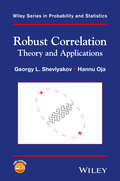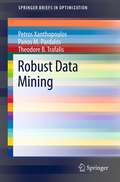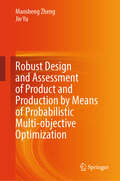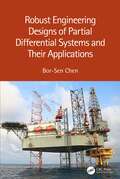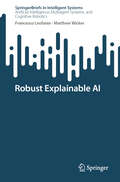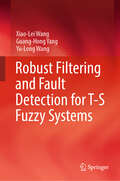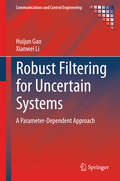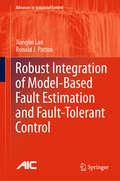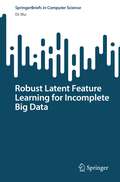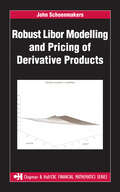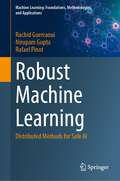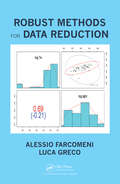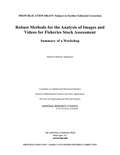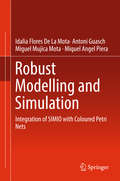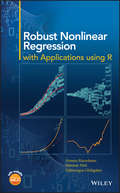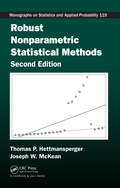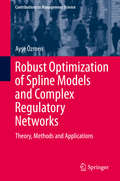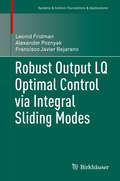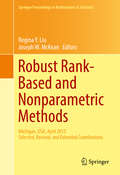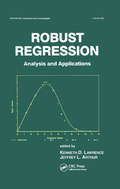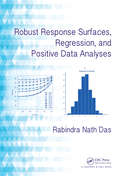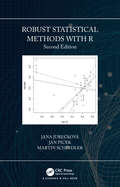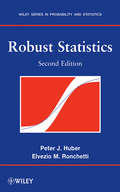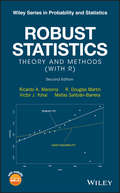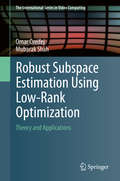- Table View
- List View
Robust Correlation: Theory and Applications
by Hannu Oja Georgy L. ShevlyakovThis bookpresents material on both the analysis of the classical concepts of correlation and on the development of their robust versions, as well as discussing the related concepts of correlation matrices, partial correlation, canonical correlation, rank correlations, with the corresponding robust and non-robust estimation procedures. Every chapter contains a set of examples with simulated and real-life data. Key features: Makes modern and robust correlation methods readily available and understandable to practitioners, specialists, and consultants working in various fields. Focuses on implementation of methodology and application of robust correlation with R. Introduces the main approaches in robust statistics, such as Huber's minimax approach and Hampel's approach based on influence functions. Explores various robust estimates of the correlation coefficient including the minimax variance and bias estimates as well as the most B- and V-robust estimates. Contains applications of robust correlation methods to exploratory data analysis, multivariate statistics, statistics of time series, and to real-life data. Includes an accompanying website featuring computer code and datasets Features exercises and examples throughout the text using both small and large data sets. Theoretical and applied statisticians, specialists in multivariate statistics, robust statistics, robust time series analysis, data analysis and signal processing will benefit from this book. Practitioners who use correlation based methods in their work as well as postgraduate students in statistics will also find this book useful.
Robust Data Mining
by Panos M. Pardalos Petros Xanthopoulos Theodore B. TrafalisData uncertainty is a concept closely related with most real life applications that involve data collection and interpretation. Examples can be found in data acquired with biomedical instruments or other experimental techniques. Integration of robust optimization in the existing data mining techniques aim to create new algorithms resilient to error and noise. This work encapsulates all the latest applications of robust optimization in data mining. This brief contains an overview of the rapidly growing field of robust data mining research field and presents the most well known machine learning algorithms, their robust counterpart formulations and algorithms for attacking these problems. This brief will appeal to theoreticians and data miners working in this field.
Robust Design and Assessment of Product and Production by Means of Probabilistic Multi-objective Optimization
by Jie Yu Maosheng ZhengThis book develops robust design and assessment of product and production from viewpoint of system theory, which is quantized with the introduction of brand new concept of preferable probability and its assessment. It aims to provide a new idea and novel way to robust design and assessment of product and production and relevant problems. Robust design and assessment of product and production is attractive to both customer and producer since the stability and insensitivity of a product’s quality to uncontrollable factors reflect its value. Taguchi method has been used to conduct robust design and assessment of product and production for half a century, but its rationality is criticized by statisticians due to its casting of both mean value of a response and its dispersion into one index, which doesn’t characterize the issue of simultaneous optimization of above two independent sub-responses sufficiently for robust design, so an appropriate approach is needed. The preference or role of a response in the evaluation is indicated by using preferable probability as the unique index. Thus, the rational approach for robust design and assessment of product and production is formulated by means of probabilistic multi-objective optimization, which reveals the simultaneous optimization of both mean value of a response and its dispersion in manner of joint probability. Besides, defuzzification and fuzzification measurements are involved as preliminary approaches for robust assessment, the latter provides miraculous treatment for the 'target the best' case flexibly.
Robust Engineering Designs of Partial Differential Systems and Their Applications
by Bor-Sen ChenMost systems in science, engineering, and biology are of partial differential systems (PDSs) modeled by partial differential equations. Many books about partial differential equations have been written by mathematicians and mainly address some fundamental mathematic backgrounds and discuss some mathematic properties of partial differential equations. Only a few books on PDSs have been written by engineers; however, these books have focused mainly on the theoretical stabilization analysis of PDSs, especially mechanical systems. This book investigates both robust stabilization control design and robust filter design and reference tracking control design in mechanical, signal processing, and control systems to fill a gap in the study of PDSs. Robust Engineering Designs of Partial Differential Systems and Their Applications offers some fundamental background in the first two chapters. The rest of the chapters focus on a specific design topic with a corresponding deep investigation into robust H∞ filtering, stabilization, or tracking design for more complex and practical PDSs under stochastic fluctuation and external disturbance. This book is aimed at engineers and scientists and addresses the gap between the theoretical stabilization results of PDSs in academic and practical engineering designs more focused on the robust H∞ filtering, stabilization, and tracking control problems of linear and nonlinear PDSs under intrinsic random fluctuation and external disturbance in industrial applications. Part I provides backgrounds on PDSs, such as Galerkin’s, and finite difference methods to approximate PDSs and a fuzzy method to approximate nonlinear PDSs. Part II examines robust H∞ filter designs for the robust state estimation of linear and nonlinear stochastic PDSs. And Part III treats robust H∞ stabilization and tracking control designs of linear and nonlinear PDSs. Every chapter focuses on an engineering design topic with both theoretical design analysis and practical design examples.
Robust Explainable AI (SpringerBriefs in Intelligent Systems)
by Francesco Leofante Matthew WickerThe area of Explainable Artificial Intelligence (XAI) is concerned with providing methods and tools to improve the interpretability of black-box learning models. While several approaches exist to generate explanations, they are often lacking robustness, e.g., they may produce completely different explanations for similar events. This phenomenon has troubling implications, as lack of robustness indicates that explanations are not capturing the underlying decision-making process of a model and thus cannot be trusted. This book aims at introducing Robust Explainable AI, a rapidly growing field whose focus is to ensure that explanations for machine learning models adhere to the highest robustness standards. We will introduce the most important concepts, methodologies, and results in the field, with a particular focus on techniques developed for feature attribution methods and counterfactual explanations for deep neural networks. As prerequisites, a certain familiarity with neural networks and approaches within XAI is desirable but not mandatory. The book is designed to be self-contained, and relevant concepts will be introduced when needed, together with examples to ensure a successful learning experience.
Robust Filtering and Fault Detection for T-S Fuzzy Systems
by Xiao-Lei Wang Guang-Hong Yang Yu-Long WangThis book conducts an in-depth research on robust filtering and fault detection for a class of T-S fuzzy systems. On the basis of the existing research on T-S fuzzy theory, robust filtering theory, and fault diagnosis theory, some new and effective technologies are proposed to solve the problems of robust filtering and fault detection for a class T-S fuzzy systems, while overcoming the shortcomings and limitations of the existing solutions. This book introduces new design solutions for a class of T-S fuzzy systems to address the existing problems in the research of robust filtering and fault detection, namely 1) two new filtering methods are explored to obtain better filtering results than the existing approaches; 2) a new event-triggered filtering scheme is proposed for T-S fuzzy systems with bounded disturbances, which realizes that the designed observer gains in the absence of event-triggered mechanisms are also applicable to the case with event-triggered mechanisms; 3) two new methods are constructed to deal with the asynchronous problems of premise variables effectively, which overcome the defects and limitations of the existing ones; and 4) an effective fault detection scheme for handling measurement outliers is constructed, which can avoid the occurrence of false alarms. This book is intended to inspire researchers and engineers, offering deeper insights into robust filtering and fault detection for T-S fuzzy systems, and equipping them with the latest advancements in fuzzy system theory, robust filtering, and fault diagnosis. It also provides valuable theoretical references for engineers tackling practical engineering problems.
Robust Filtering for Uncertain Systems
by Huijun Gao Xianwei LiThis monograph provides the reader with a systematic treatment of robust filter design, a key issue in systems, control and signal processing, because of the fact that the inevitable presence of uncertainty in system and signal models often degrades the filtering performance and may even cause instability. The methods described are therefore not subject to the rigorous assumptions of traditional Kalman filtering. The monograph is concerned with robust filtering for various dynamical systems with parametric uncertainties and focuses on parameter-dependent approaches to filter design. Classical filtering schemes, like H2 filtering and H¥ filtering, are addressed and emerging issues such as robust filtering with constraints on communication channels and signal frequency characteristics are discussed. The text features: · design approaches to robust filters arranged according to varying complexity level and emphasizing robust filtering in the parameter-dependent framework for the first time; · guidance on the use of special realistic phenomena or factors to describe problems more accurately and to improve filtering performance; · a unified linear matrix inequality formulation of design approaches for easy and effective filter design; · demonstration of the techniques of matrix decoupling technique, the generalized Kalmanâe'Yakubovichâe'Popov lemma, the free weighting matrix technique and the delay modelling approach, in robust filtering; · numerous easy-to-follow simulation examples, graphical and tabular illustrations to help the reader understand the filter design approaches developed; and · an account of emerging issues on robust filtering for research to inspire future investigation. Robust Filtering for Uncertain Systems will be of interest to academic researchers specializing in linear, robust and optimal control and estimation and to practitioners working in tracking and network control or signal filtering, detection and estimation. Graduate students learning control and systems theory, signal processing or applied mathematics will also find the book to be a valuable resource.
Robust Integration of Model-Based Fault Estimation and Fault-Tolerant Control (Advances in Industrial Control)
by Jianglin Lan Ronald J. PattonRobust Integration of Model-Based Fault Estimation and Fault-Tolerant Control is a systematic examination of methods used to overcome the inevitable system uncertainties arising when a fault estimation (FE) function and a fault-tolerant controller interact as they are employed together to compensate for system faults and maintain robustly acceptable system performance. It covers the important subject of robust integration of FE and FTC with the aim of guaranteeing closed-loop stability. The reader’s understanding of the theory is supported by the extensive use of tutorial examples, including some MATLAB®-based material available from the Springer website and by industrial-applications-based material. The text is structured into three parts:Part I examines the basic concepts of FE and FTC, providing extensive insight into the importance of and challenges involved in their integration;Part II describes five effective strategies for the integration of FE and FTC: sequential, iterative, simultaneous, adaptive-decoupling, and robust decoupling; andPart III begins to extend the proposed strategies to nonlinear and large-scale systems and covers their application in the fields of renewable energy, robotics and networked systems. The strategies presented are applicable to a broad range of control problems, because in the absence of faults the FE-based FTC naturally reverts to conventional observer-based control. The book is a useful resource for researchers and engineers working in the area of fault-tolerant control systems, and supplementary material for a graduate- or postgraduate-level course on fault diagnosis and FTC.Advances in Industrial Control reports and encourages the transfer of technology in control engineering. The rapid development of control technology has an impact on all areas of the control discipline. The series offers an opportunity for researchers to present an extended exposition of new work in all aspects of industrial control.
Robust Latent Feature Learning for Incomplete Big Data (SpringerBriefs in Computer Science)
by Di WuIncomplete big data are frequently encountered in many industrial applications, such as recommender systems, the Internet of Things, intelligent transportation, cloud computing, and so on. It is of great significance to analyze them for mining rich and valuable knowledge and patterns. Latent feature analysis (LFA) is one of the most popular representation learning methods tailored for incomplete big data due to its high accuracy, computational efficiency, and ease of scalability. The crux of analyzing incomplete big data lies in addressing the uncertainty problem caused by their incomplete characteristics. However, existing LFA methods do not fully consider such uncertainty. In this book, the author introduces several robust latent feature learning methods to address such uncertainty for effectively and efficiently analyzing incomplete big data, including robust latent feature learning based on smooth L1-norm, improving robustness of latent feature learning using L1-norm, improving robustness of latent feature learning using double-space, data-characteristic-aware latent feature learning, posterior-neighborhood-regularized latent feature learning, and generalized deep latent feature learning. Readers can obtain an overview of the challenges of analyzing incomplete big data and how to employ latent feature learning to build a robust model to analyze incomplete big data. In addition, this book provides several algorithms and real application cases, which can help students, researchers, and professionals easily build their models to analyze incomplete big data.
Robust Libor Modelling and Pricing of Derivative Products (Chapman and Hall/CRC Financial Mathematics Series)
by John SchoenmakersOne of Riskbook.com's Best of 2005 - Top Ten Finance BooksThe Libor market model remains one of the most popular and advanced tools for modelling interest rates and interest rate derivatives, but finding a useful procedure for calibrating the model has been a perennial problem. Also the respective pricing of exotic derivative products such
Robust Machine Learning: Distributed Methods for Safe AI (Machine Learning: Foundations, Methodologies, and Applications)
by Rachid Guerraoui Nirupam Gupta Rafael PinotToday, machine learning algorithms are often distributed across multiple machines to leverage more computing power and more data. However, the use of a distributed framework entails a variety of security threats. In particular, some of the machines may misbehave and jeopardize the learning procedure. This could, for example, result from hardware and software bugs, data poisoning or a malicious player controlling a subset of the machines. This book explains in simple terms what it means for a distributed machine learning scheme to be robust to these threats, and how to build provably robust machine learning algorithms. Studying the robustness of machine learning algorithms is a necessity given the ubiquity of these algorithms in both the private and public sectors. Accordingly, over the past few years, we have witnessed a rapid growth in the number of articles published on the robustness of distributed machine learning algorithms. We believe it is time to provide a clear foundation to this emerging and dynamic field. By gathering the existing knowledge and democratizing the concept of robustness, the book provides the basis for a new generation of reliable and safe machine learning schemes. In addition to introducing the problem of robustness in modern machine learning algorithms, the book will equip readers with essential skills for designing distributed learning algorithms with enhanced robustness. Moreover, the book provides a foundation for future research in this area.
Robust Methods for Data Reduction
by Alessio Farcomeni Luca GrecoRobust Methods for Data Reduction gives a non-technical overview of robust data reduction techniques, encouraging the use of these important and useful methods in practical applications. The main areas covered include principal components analysis, sparse principal component analysis, canonical correlation analysis, factor analysis, clustering, dou
Robust Methods for the Analysis of Images and Videos for Fisheries Stock Assessment: Summary of a Workshop
by Maureen MellodyThe National Marine Fisheries Service (NMFS) is responsible for the stewardship of the nation's living marine resources and their habitat. As part of this charge, NMFS conducts stock assessments of the abundance and composition of fish stocks in several bodies of water. At present, stock assessments rely heavily on human data-gathering and analysis. Automatic means of fish stock assessments are appealing because they offer the potential to improve efficiency and reduce human workload and perhaps develop higher-fidelity measurements. The use of images and video, when accompanies by appropriate statistical analyses of the inferred data, is of increasing importance for estimating the abundance of species and their age distributions. "Robust Methods for the Analysis of Images and Videos for Fisheries Stock Assessment" is the summary of a workshop convened by the National Research Council Committee on Applied and Theoretical Statistics to discuss analysis techniques for images and videos for fisheries stock assessment. Experts from diverse communities shared perspective about the most efficient path toward improved automation of visual information and discussed both near-term and long-term goals that can be achieved through research and development efforts. This report is a record of the presentations and discussions of this event.
Robust Modelling and Simulation
by Miguel Mujica Mota Idalia Flores De La Mota Antoni Guasch Miquel Angel PieraThis book presents for the first time a methodology that combines the power of a modelling formalism such as colored petri nets with the flexibility of a discrete event program such as SIMIO. Industrial practitioners have seen the growth of simulation as a methodology for tacking problems in which variability is the common denominator. Practically all industrial systems, from manufacturing to aviation are considered stochastic systems. Different modelling techniques have been developed as well as mathematical techniques for formalizing the cause-effect relationships in industrial and complex systems. The methodology in this book illustrates how complexity in modelling can be tackled by the use of coloured petri nets, while at the same time the variability present in systems is integrated in a robust fashion. The book can be used as a concise guide for developing robust models, which are able to efficiently simulate the cause-effect relationships present in complex industrial systems without losing the simulation power of discrete-event simulation. In addition SIMIO's capabilities allows integration of features that are becoming more and more important for the success of projects such as animation, virtual reality, and geographical information systems (GIS).
Robust Nonlinear Regression: with Applications using R
by Gebrenegus Ghilagaber Hossein Riazoshams Habshah MidiThe first book to discuss robust aspects of nonlinear regression—with applications using R software Robust Nonlinear Regression: with Applications using R covers a variety of theories and applications of nonlinear robust regression. It discusses both parts of the classic and robust aspects of nonlinear regression and focuses on outlier effects. It develops new methods in robust nonlinear regression and implements a set of objects and functions in S-language under SPLUS and R software. The software covers a wide range of robust nonlinear fitting and inferences, and is designed to provide facilities for computer users to define their own nonlinear models as an object, and fit models using classic and robust methods as well as detect outliers. The implemented objects and functions can be applied by practitioners as well as researchers. The book offers comprehensive coverage of the subject in 9 chapters: Theories of Nonlinear Regression and Inference; Introduction to R; Optimization; Theories of Robust Nonlinear Methods; Robust and Classical Nonlinear Regression with Autocorrelated and Heteroscedastic errors; Outlier Detection; R Packages in Nonlinear Regression; A New R Package in Robust Nonlinear Regression; and Object Sets. The first comprehensive coverage of this field covers a variety of both theoretical and applied topics surrounding robust nonlinear regression Addresses some commonly mishandled aspects of modeling R packages for both classical and robust nonlinear regression are presented in detail in the book and on an accompanying website Robust Nonlinear Regression: with Applications using R is an ideal text for statisticians, biostatisticians, and statistical consultants, as well as advanced level students of statistics.
Robust Nonparametric Statistical Methods (Chapman & Hall/CRC Monographs on Statistics and Applied Probability)
by Thomas P. Hettmansperger Joseph W. McKeanPresenting an extensive set of tools and methods for data analysis, Robust Nonparametric Statistical Methods, Second Edition covers univariate tests and estimates with extensions to linear models, multivariate models, times series models, experimental designs, and mixed models. It follows the approach of the first edition by developing rank-based m
Robust Optimization of Spline Models and Complex Regulatory Networks
by Ayşe ÖzmenThis book introduces methods of robust optimization in multivariateadaptive regression splines (MARS) and Conic MARS in order to handleuncertainty and non-linearity. The proposed techniques are implemented andexplained in two-model regulatory systems that can be found in the financialsector and in the contexts of banking, environmental protection, system biologyand medicine. The book provides necessarybackground information on multi-model regulatory networks, optimizationand regression. It presents the theory of and approaches to robust (conic)multivariate adaptive regression splines - R(C)MARS - and robust (conic)generalized partial linear models - R(C)GPLM - under polyhedral uncertainty. Further,it introduces spline regression models for multi-model regulatory networks andinterprets (C)MARS results based on different datasets for the implementation. It explains robust optimization in these models in terms of both the theory andmethodology. In this context it studies R(C)MARS results with differentuncertainty scenarios for a numerical example. Lastly, the book demonstratesthe implementation of the method in a number of applications from thefinancial, energy, and environmental sectors, and provides an outlook on futureresearch.
Robust Output LQ Optimal Control via Integral Sliding Modes
by Leonid Fridman Alexander Poznyak Francisco Javier BejaranoFeaturing original research from well-known experts in the field of sliding mode control, this book presents new design schemes for a useful and practical optimal control with very few impractical assumptions. The results presented allow optimal control theory to grow in its applicability to real-world systems. On the cutting-edge of optimal control research, this book is an excellent resource for both graduate students and researchers in engineering, mathematics, and optimal control.
Robust Rank-Based and Nonparametric Methods
by Regina Y. Liu Joseph W. MckeanThe contributors to this volume include many of the distinguished researchers in this area. Many of these scholars have collaborated with Joseph McKean to develop underlying theory for these methods, obtain small sample corrections, and develop efficient algorithms for their computation. The papers cover the scope of the area, including robust nonparametric rank-based procedures through Bayesian and big data rank-based analyses. Areas of application include biostatistics and spatial areas. Over the last 30 years, robust rank-based and nonparametric methods have developed considerably. These procedures generalize traditional Wilcoxon-type methods for one- and two-sample location problems. Research into these procedures has culminated in complete analyses for many of the models used in practice including linear, generalized linear, mixed, and nonlinear models. Settings are both multivariate and univariate. With the development of R packages in these areas, computation of these procedures is easily shared with readers and implemented. This book is developed from the International Conference on Robust Rank-Based and Nonparametric Methods, held at Western Michigan University in April 2015.
Robust Regression: Analysis and Applications
by Kenneth D. LawrenceRobust Regression: Analysis and Applications characterizes robust estimators in terms of how much they weight each observation discusses generalized properties of Lp-estimators. Includes an algorithm for identifying outliers using least absolute value criterion in regression modeling reviews redescending M-estimators studies Li linear regression proposes the best linear unbiased estimators for fixed parameters and random errors in the mixed linear model summarizes known properties of Li estimators for time series analysis examines ordinary least squares, latent root regression, and a robust regression weighting scheme and evaluates results from five different robust ridge regression estimators.
Robust Response Surfaces, Regression, and Positive Data Analyses
by Rabindra Nath DasShowing how robust response surface methodology (RRSM) can overcome the limitations of RSM, this book presents RRS designs, along with the relevant regression and positive data analysis techniques. It explains how to use RRSM in experimental designs and regression analysis and addresses problems of RRS designs, such as rotatability, slope-rotatability, weak rotatability, and optimality. The author illustrates the concepts and methods with real examples of lifetime responses, resistivity, replicated measures, and more.
Robust Statistical Methods with R, Second Edition
by Martin Schindler Jana Jurečková Jan PicekThe second edition of Robust Statistical Methods with R provides a systematic treatment of robust procedures with an emphasis on new developments and on the computational aspects. There are many numerical examples and notes on the R environment, and the updated chapter on the multivariate model contains additional material on visualization of multivariate data in R. A new chapter on robust procedures in measurement error models concentrates mainly on the rank procedures, less sensitive to errors than other procedures. This book will be an invaluable resource for researchers and postgraduate students in statistics and mathematics. Features • Provides a systematic, practical treatment of robust statistical methods • Offers a rigorous treatment of the whole range of robust methods, including the sequential versions of estimators, their moment convergence, and compares their asymptotic and finite-sample behavior • The extended account of multivariate models includes the admissibility, shrinkage effects and unbiasedness of two-sample tests • Illustrates the small sensitivity of the rank procedures in the measurement error model • Emphasizes the computational aspects, supplies many examples and illustrations, and provides the own procedures of the authors in the R software on the book’s website
Robust Statistics: The Approach Based On Influence Functions (Wiley Series in Probability and Statistics #693)
by Peter J. Huber Elvezio M. RonchettiA new edition of the classic, groundbreaking book on robust statistics Over twenty-five years after the publication of its predecessor, Robust Statistics, Second Edition continues to provide an authoritative and systematic treatment of the topic. This new edition has been thoroughly updated and expanded to reflect the latest advances in the field while also outlining the established theory and applications for building a solid foundation in robust statistics for both the theoretical and the applied statistician. A comprehensive introduction and discussion on the formal mathematical background behind qualitative and quantitative robustness is provided, and subsequent chapters delve into basic types of scale estimates, asymptotic minimax theory, regression, robust covariance, and robust design. In addition to an extended treatment of robust regression, the Second Edition features four new chapters covering: Robust Tests Small Sample Asymptotics Breakdown Point Bayesian Robustness An expanded treatment of robust regression and pseudo-values is also featured, and concepts, rather than mathematical completeness, are stressed in every discussion. Selected numerical algorithms for computing robust estimates and convergence proofs are provided throughout the book, along with quantitative robustness information for a variety of estimates. A General Remarks section appears at the beginning of each chapter and provides readers with ample motivation for working with the presented methods and techniques. Robust Statistics, Second Edition is an ideal book for graduate-level courses on the topic. It also serves as a valuable reference for researchers and practitioners who wish to study the statistical research associated with robust statistics.
Robust Statistics: Theory and Methods (with R) (Wiley Series in Probability and Statistics)
by Ricardo A. Maronna R. Douglas Martin Victor J. Yohai Matías Salibián-BarreraA new edition of this popular text on robust statistics, thoroughly updated to include new and improved methods and focus on implementation of methodology using the increasingly popular open-source software R. Classical statistics fail to cope well with outliers associated with deviations from standard distributions. Robust statistical methods take into account these deviations when estimating the parameters of parametric models, thus increasing the reliability of fitted models and associated inference. This new, second edition of Robust Statistics: Theory and Methods (with R) presents a broad coverage of the theory of robust statistics that is integrated with computing methods and applications. Updated to include important new research results of the last decade and focus on the use of the popular software package R, it features in-depth coverage of the key methodology, including regression, multivariate analysis, and time series modeling. The book is illustrated throughout by a range of examples and applications that are supported by a companion website featuring data sets and R code that allow the reader to reproduce the examples given in the book. Unlike other books on the market, Robust Statistics: Theory and Methods (with R) offers the most comprehensive, definitive, and up-to-date treatment of the subject. It features chapters on estimating location and scale; measuring robustness; linear regression with fixed and with random predictors; multivariate analysis; generalized linear models; time series; numerical algorithms; and asymptotic theory of M-estimates. Explains both the use and theoretical justification of robust methods Guides readers in selecting and using the most appropriate robust methods for their problems Features computational algorithms for the core methods Robust statistics research results of the last decade included in this 2nd edition include: fast deterministic robust regression, finite-sample robustness, robust regularized regression, robust location and scatter estimation with missing data, robust estimation with independent outliers in variables, and robust mixed linear models. Robust Statistics aims to stimulate the use of robust methods as a powerful tool to increase the reliability and accuracy of statistical modelling and data analysis. It is an ideal resource for researchers, practitioners, and graduate students in statistics, engineering, computer science, and physical and social sciences.
Robust Subspace Estimation Using Low-Rank Optimization
by Omar Oreifej Mubarak ShahVarious fundamental applications in computer vision and machine learning require finding the basis of a certain subspace. Examples of such applications include face detection, motion estimation, and activity recognition. An increasing interest has been recently placed on this area as a result of significant advances in the mathematics of matrix rank optimization. Interestingly, robust subspace estimation can be posed as a low-rank optimization problem, which can be solved efficiently using techniques such as the method of Augmented Lagrange Multiplier. In this book, the authors discuss fundamental formulations and extensions for low-rank optimization-based subspace estimation and representation. By minimizing the rank of the matrix containing observations drawn from images, the authors demonstrate how to solve four fundamental computer vision problems, including video denosing, background subtraction, motion estimation, and activity recognition.
